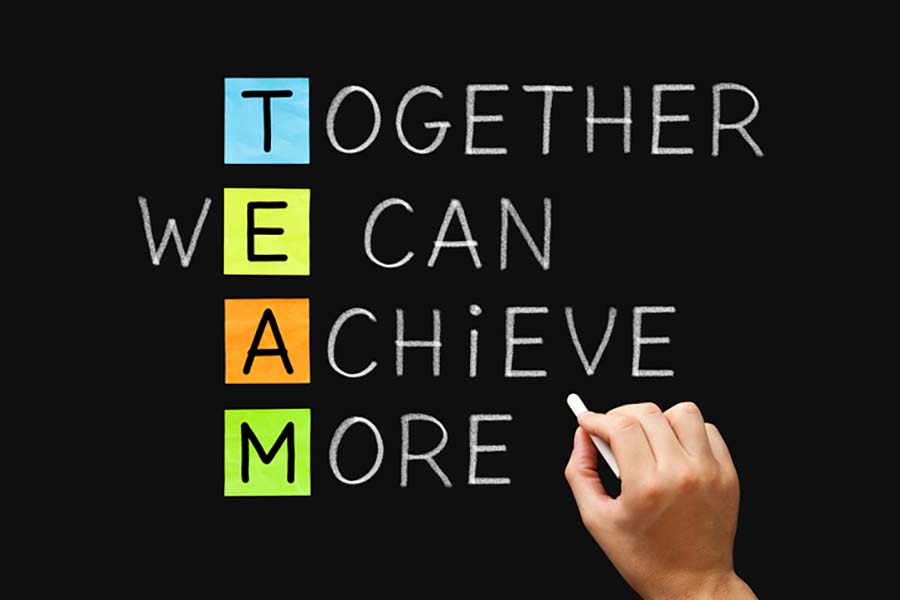Have you ever mistaken a coworker’s intention or misread a situation?
If so, you’re not alone. To overcome these potential challenges, try this online “Power Combo” team building. It centers on enhancing communication and improving team dynamics. As more of us are working remotely, it’s even more paramount to make sure you’re being understood the way you intended.
Part 1 – Focuses on attaining knowledge around key aspects of your individual personality, behavior, and preferences through assessments.
The Myers-Briggs Type Indicator (MBTI®)
It’s designed to help us understand our innate preferences based on the theory that random variation in behavior is actually quite orderly and consistent, due to basic differences in the way we prefer to use our perception and judgment. The MBTI is based on the work of Carl G. Jung and measures individual preferences on four dichotomies:
- Extroversion or Introversion: Whether you relate more to the external or internal world.
- Sensing or Intuition: How you prefer to take in information.
- Thinking or Feeling: Your preferred way to make evaluations and decisions.
- Judging or Perceiving: Your approach to life; are you organized and seek closure or prefer to live more spontaneous and open.
Fundamental Interpersonal Relations Orientation™-Behavior (FIRO®-B)
The FIRO examines interpersonal relationships. William Shultz, Ph.D. developed the instrument on the theory that beyond our survival needs – food, shelter, and warmth – we each have distinctive interpersonal needs that strongly motivate us. These needs he labeled: Inclusion/Involvement, Control/Influence, and Affection/Connection.
As a result, the team will gain insight into how:
- You come across to others – and why this way may not be the way you see yourself.
- Conflicts develop between well-meaning people.
- You express your own needs as you interact with others.
Part 2 – The team affirms and shares learnings.
After everyone finishes their individual assessments, you’ll participate in an interactive dialogue via an online platform (WebEx, Zoom, Skype, etc.). On this call, you’ll learn about each assessment in more depth and have the chance to self-report. During the session, everyone will receive their actual reports through email with a guided discussion around self-reporting and affirming their best-fit Type. In this trusted environment, team members share their Types and insights. As a next step, the facilitator takes the data to transform it overnight into visuals that showcase the team output. Whereas, participants are asked to prepare for their individual and team action planning thoughts for the next session.
Part 3 – Prioritize and create a team action plan.
In part three, the facilitator kicks-off the session by presenting the visuals and reminding participants about their common goal to “improve communication and enhance team dynamics.” From here, the action planning begins. In an organized manner, each team member shares one thing they will do differently, as well as recommends one item the team should do differently based on the learnings from the previous session. The facilitator documents the information on the screen, and leads a voting and prioritizing session. As a result, the team has an action plan that consists of small and simple changes that everyone can adhere to with respect and understanding of others. For example:
I’ve heard from many people that their calendars are beginning to be filled with meeting after meeting. As a solution, a new team tenet could be centered around what information is sent via email and what information warrants a meeting. Another small change could be that everyone always includes a purpose or agenda with the call invite to allow people to prepare, recognizing that our mindset differs for a status update versus a brainstorming meeting. You may also agree to specific durations and times for meetings, all out of respect for others’ preferences.
As a final step, the team lead distributes the action plan, which includes scheduled milestone check-ins.
By learning together, you build trust and foster stronger relationships.
Don’t let environmental aspects and unpredictable changes negatively impact you or your team. Instead, encourage continuous dialogue and appreciation for others’ preferences and needs. As you become more open and honest with others, you can adapt to the ever-changing work environment and stay focused on succeeding together.

